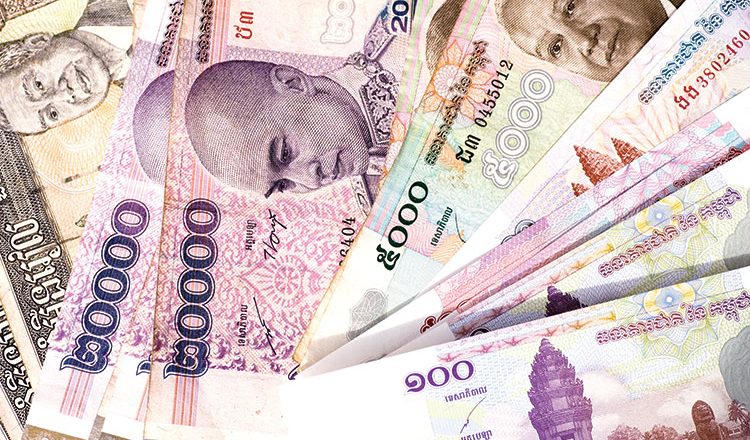Cambodia: Evolution of five rare Riel banknotes
All riel banknotes have the unmistakable imprint of the Kingdom’s economic elements and cultural identity, yet there are some specific bills that numismatists drool upon. Khmer Times has carefully picked the rarest riel banknotes still in circulation, which possess the highest values as collectables in this part of de-dollarisation series. They have been essentially hand-picked based on various criteria, from designs to historical as well as contemporary significance
Almost all riel banknotes designed by the National Bank of Cambodia bear beautiful designs that reflect the Kingdom’s economic elements and cultural identity. Yet, there are some specific bills that numismatists drool upon.
Khmer Times has selected the rarest riel banknotes still in circulation, which possess the highest values as collectables in this edition. They have been chosen based on various criteria, from designs to their historical and contemporary reflections.
200 RIEL NOTE (1995)
Despite still being marked as “in circulation”, it is rare to run into this banknote in transaction today, considering that 100 riel banknotes has witnessed more demand than the 200 riel ones for small banknotes over the years. While it is true that they are over 20 years old, most of the violet-and-green notes which still exist today are in excellent condition. Many Cambodian people, especially those born in the early 90s, keep them in their wallets for luck or nostalgic values, for 200 riels were the usual allowance they had per day as children.
The bill’s face bears the picture of the irrigation sluice gates on the right and the Royal Coat of Arms on the left. Meanwhile, the centre of the back has an image of the four-face of the Avalokitesvara Bodhisattva.
1,000 RIEL NOTE (1999)
The face of this 1,000 riel note shows Bayon temple, which symbolises the glorious culture of the Khmer people and the remarkable reign of King Jayavarman VII, along with the five-headed naga. While this is familiar in-house money, the back made it valuable, featuring a scene of “Troh” bridge construction along the National Road No 6.
The brown and green surface gives the note a retro look, while the beautiful kbach or decorative patterns preserve its classiness. It is no coincidence that it is one of the most wanted collectables on Numista.com.
15,000 RIEL NOTE (2019)
We will begin at the top of the list with an award-winning commemorative riel banknote. The 15,000 riel note, issued on October 7, 2019, to celebrate the 15th anniversary of His Majesty King Norodom Sihamoni’s coronation, was awarded the Best New Banknote by the High Security Printing (HSP) Asia.
The face of the note has a portrait of the King in the centre, next to a seven-headed naga’s status at Angkor Wat, the symbolic mythical creature and protector of the monarch. The other side features King Sihamoni with his parents on the coronation day with the artwork that combines the cultural aspect with the country’s modern achievement. Printed with three different UV fluorescent inks, it has a unique see-through image and two-colour serial numbering with different inks.
The bill is also the first in Southeast Asia, printed on Landqart’s Durasafe composite substrate.
100,000 RIEL NOTE (1995)
For over 30 years, the 1995 version of the 100,000-riel banknote has been known as the local bill with the highest face value until the 2013 version mostly replaced it. And even during its time, it was already rarely seen in the market.
The bill was historic as it was the first-ever paper money to display the pictures of King Father Norodom Sihanouk and Queen Mother Monineath Sihanouk. It was also the first time in Cambodia’s currency history that a female monarch’s portrait appeared on the currency. On the back is a scene showing the then King and Queen receiving the homage of the people, reflecting on the monarch’s compassion and modesty.
30,000 RIEL NOTE (2021)

Our list will end with another commemorative banknote. The 30,000 Riel Note was issued on October 18, 2021. Despite being the newest bill in Cambodia, it makes history for many reasons.
Its printing was to celebrate the 30th anniversary of the Paris Peace Agreement (October 23, 1991 – October 23, 2021) and the 30th anniversary of the return of His Majesty King Norodom Sihanouk to Cambodia (November 14, 1991- November 14, 2021). This also marks the first time the National Bank of Cambodia issues a currency with the number 3 in the face value. It is also the first banknote bearing an image of Prime Minister Hun Sen, showing the young premier on an open-roof car with the great King in 1991, as both of them waving to a cheering crowd.
It is almost impossible to find this banknote in daily transactions since people who possess it will keep the valuable bill for their personal collection rather than spend it.
Corrigendum: Noë Schellinck’s quote in the article ‘De-dollarisation: Views from Asia, US and Europe’ (March 28, 2022) should have been read: “To a certain extent, the dollarisation now can be ascribed to the success of the Cambodian economy, with a great influx of FDI, compared to the historic context of when the dollarisation came about. Strong regulatory changes that would actively discourage the use of US Dollar have the potential to shake confidence. On the other hand, positive actions to promote the Khmer Riel through a soft transition process with sufficient flanking measures, such as the launching of the Bakong app, are less likely to have such effect. The public cost of the unofficial dollarisation, such as the loss of seigniorage for the government, should be weighed against the broad benefits it brings, on the basis of economic data. We stand ready to support the government in this difficult policy debate.” — Ed
Source: https://www.khmertimeskh.com/501049066/evolution-of-five-rare-riel-banknotes-2/


 English
English












